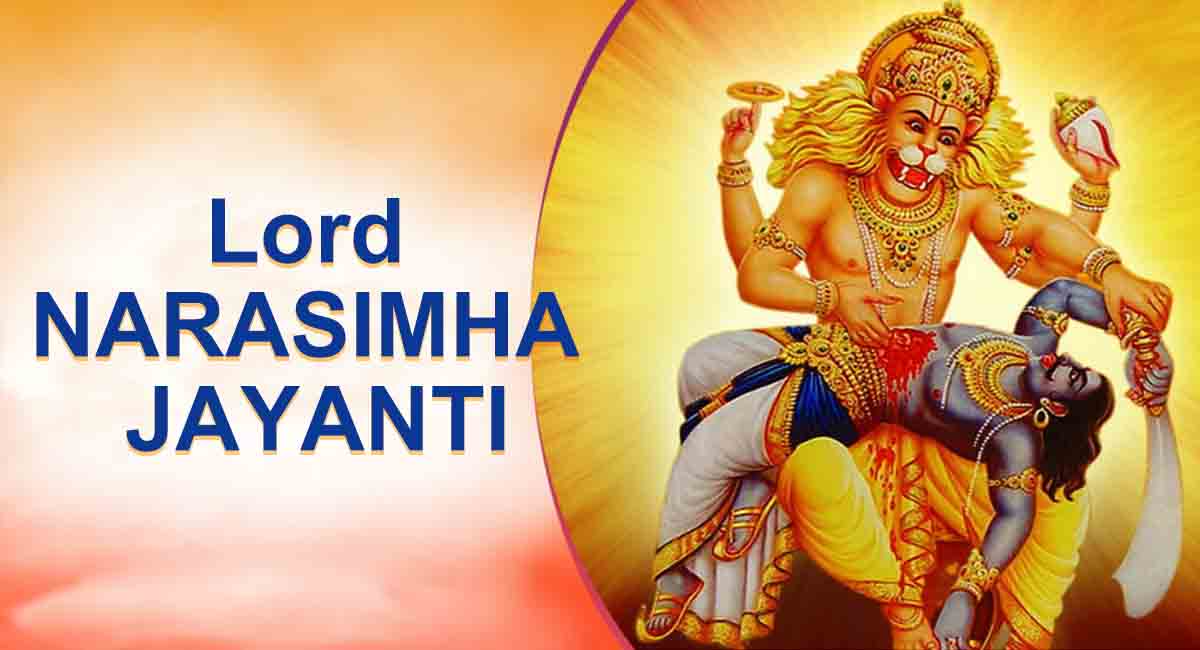Narasimha Jayanti is an auspicious Hindu festival celebrated annually to commemorate the birth of Lord Narasimha, the fourth incarnation of Lord Vishnu. This festival falls on the 14th day of the Shukla Paksha in the Hindu month of Vaishakha, which typically falls in late April or early May. In 2024, Narasimha Jayanti will be celebrated on May 4th.
Important Timings On Narasimha Jayanti 2024
| Narasimha Jayanti 2024 Date | Thursday, May 21, 2024 |
| Narasimha Jayanti Sayana Kala Puja Time | 04:24 PM to 07:09 PM |
| Next Day Parana Time for Narasimha Jayanti | after 12:18 PM, May 22, 2024 |
| Narasimha Jayanti Madhyahna Sankalp Time | 10:56 AM to 01:40 PM |
| Chaturdashi Tithi Begins | 05:39 PM on May 21, 2024 |
| Chaturdashi Tithi Ends | 06:47 PM on May 22, 2024 |
Significance of Narasimha Jayanti 2024
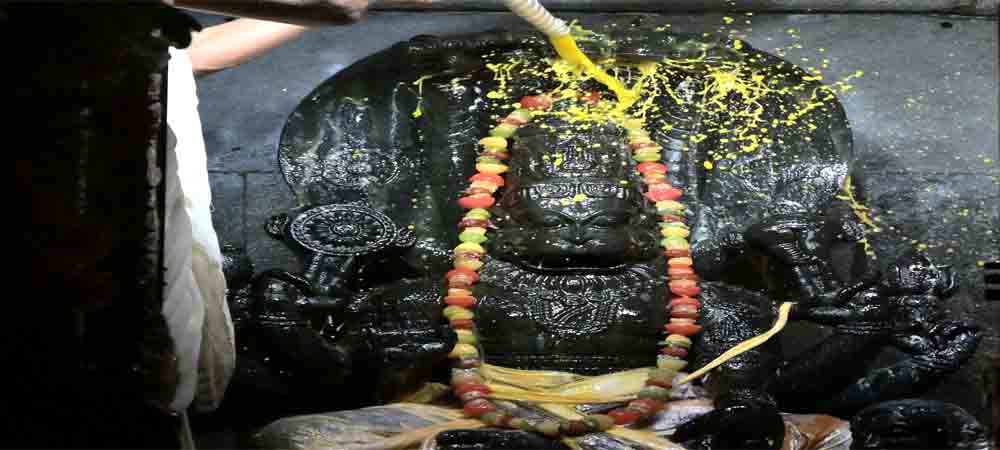
Narasimha Jayanti is an important festival in Hindu mythology and is celebrated to commemorate the victory of good over evil. Lord Narasimha is revered as a protector of his devotees and is believed to have destroyed all negative energies and obstacles in their path. This festival reminds devotees of the power of faith, devotion, and righteousness in their lives. It is believed that observing fasts, offering prayers, and seeking blessings from Lord Narasimha can help overcome all obstacles and negative energies in life.
A Brief History of Narasimha Avatar
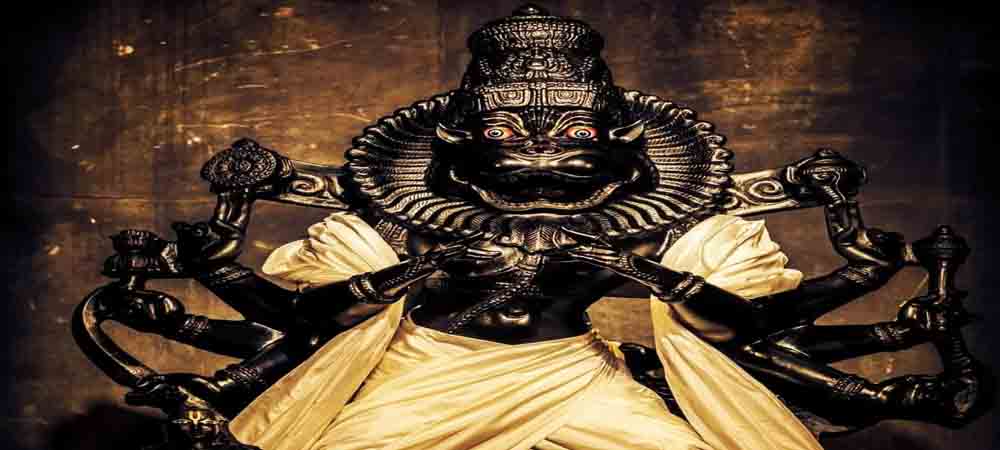
The story of the Narasimha avatar is an enthralling tale that demonstrates the power of faith and devotion. According to Hindu mythology, Lord Vishnu took the form of a half-man and half-lion, known as Narasimha, to save his devotee Prahlada from the atrocities of his father, the demon king Hiranyakashipu. Prahlada was a devout follower of Lord Vishnu, which angered his father, who wanted his son to worship him instead.
Hiranyakashipu made several attempts to kill his son, but Lord Narasimha appeared to protect Prahlada and kill Hiranyakashipu. Lord Narasimha is believed to have emerged from a pillar in the palace and killed Hiranyakashipu with his sharp claws. This legend is retold during the Narasimha Jayanti celebrations.
Observance of Narasimha Jayanti 2024
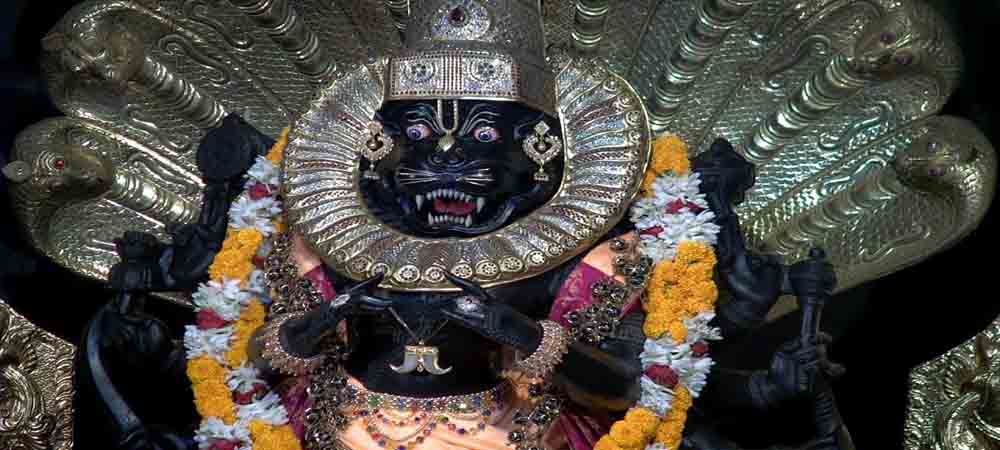
Narasimha Jayanti is an important Hindu festival that is celebrated with great devotion and enthusiasm across India. It falls on the 14th day of the Shukla Paksha in the Hindu month of Vaishakha, which typically falls in late April or early May. The festival is observed with great fervor in temples and households dedicated to Lord Narasimha.
Date and Timing of Narasimha Jayanti
The Hindu lunar calendar determines the date of Narasimha Jayanti which usually falls in late April or early May. The festival is celebrated on the 14th day of the Shukla Paksha in the Hindu month of Vaishakha, which corresponds to the Gregorian calendar.
Celebrations in Different Parts of India
Narasimha Jayanti is celebrated with great enthusiasm in different parts of India. In the southern states of India, especially in Andhra Pradesh and Tamil Nadu, the festival is celebrated with grandeur in temples dedicated to Lord Narasimha. Devotees flock to these temples to offer prayers and seek blessings from the deity.
In the northern states of India, especially in Rajasthan, the festival is celebrated with a unique tradition of “Holika Dahan,” where a bonfire is lit to signify the destruction of evil forces. In Maharashtra, the festival is celebrated as “Narsoba Wadi,” where devotees offer puja and seek blessings from the deity.
Special Rituals and Puja on Narasimha Jayanti
On Narasimha Jayanti, devotees offer special prayers and perform puja to seek blessings from Lord Narasimha. The puja involves offering flowers, fruits, and sweets to the deity, along with the recitation of hymns and mantras. Devotees also observe fasts on this day as a mark of devotion and seek blessings from the deity.
The Legend of Narasimha Avatar
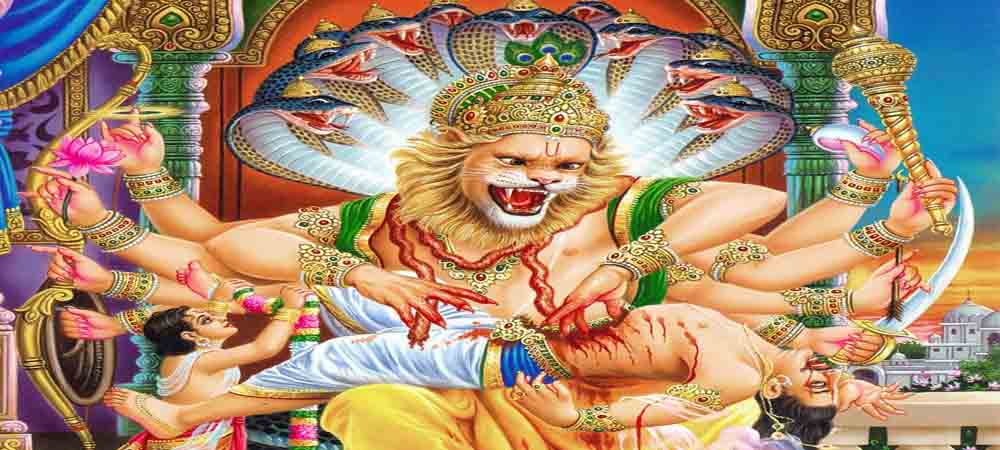
Narasimha Avatar is one of the ten incarnations of Lord Vishnu in Hindu mythology. The story of Narasimha Avatar is a popular tale in Hindu mythology that symbolizes the triumph of good over evil. The story goes that Hiranyakashipu, a demon king, was granted a boon that he would be invincible and could not be killed by any man or beast, day or night, indoors or outdoors. He became arrogant and started to terrorize the world. He considered himself to be a god and demanded that everyone worship him instead of Lord Vishnu.
Significance of Hiranyakashipu and Prahlada in the Story
Hiranyakashipu’s own son, Prahlada, was a devotee of Lord Vishnu and refused to worship his father. This infuriated Hiranyakashipu, and he attempted to kill Prahlada multiple times, but Lord Vishnu always protected him. Finally, Hiranyakashipu decided to take matters into his own hands and challenged Lord Vishnu to a fight. Lord Vishnu appeared as Narasimha, a half-man, half-lion creature, at twilight (neither day nor night), on the threshold of a palace (neither indoors nor outdoors), and killed Hiranyakashipu with his sharp claws.
Lessons From Narasimha Avatar for Modern Times
The legend of Narasimha Avatar teaches us several important lessons that are relevant even in modern times. Firstly, it emphasizes the importance of devotion and faith in God. Despite facing numerous challenges, Prahlada remained steadfast in his devotion to Lord Vishnu, which ultimately saved him from his father’s wrath. Secondly, the story teaches us the significance of standing up for what is right, even in the face of adversity. Prahlada refused to worship his father, even though it meant risking his life, and his courage ultimately led to his father’s downfall. Lastly, the story highlights the fact that even the most powerful beings are not invincible, and that karma eventually catches up with everyone.
Lord Narasimha Temples
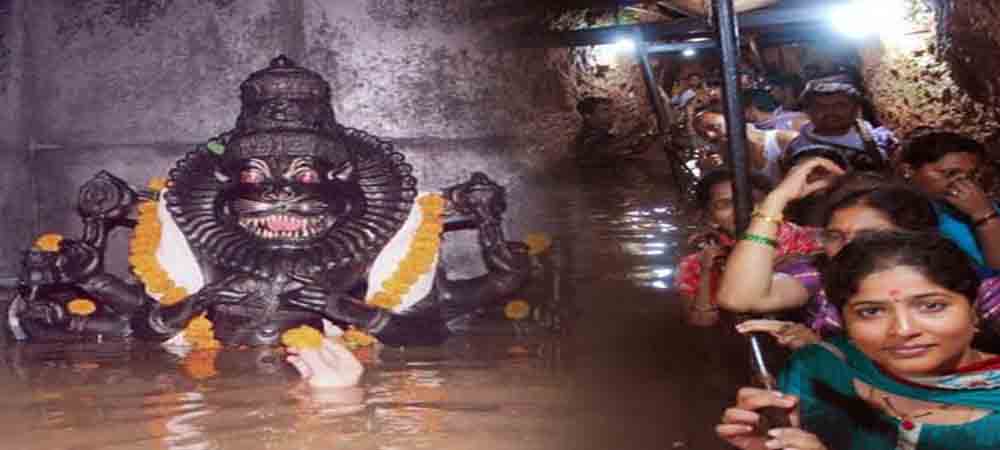
Narasimha, the half-man, half-lion incarnation of Lord Vishnu, is one of the most revered deities in Hinduism. There are several temples dedicated to Lord Narasimha across India that are significant pilgrimage sites for devotees.
Famous Narasimha Temples in India
One of the most famous Narasimha temples is the Ahobilam Temple in Andhra Pradesh, which is believed to be the place where Lord Narasimha appeared to slay Hiranyakashipu. Other famous temples include the Narasimha Swamy Temple in Namakkal, Tamil Nadu, and the Narasimha Temple in Hampi, Karnataka. The Narasimha Temple in Vrindavan, Uttar Pradesh, is also a significant pilgrimage site for devotees.
Importance of These Temples for Devotees
Devotees believe that visiting these temples and offering prayers to Lord Narasimha can bring them blessings, protection, and success in life. Many devotees also perform special rituals and puja on Narasimha Jayanti, which is the annual celebration of the birth of Lord Narasimha.
The Architectural and Historical Significance of These Temples
Many of the Narasimha temples in India are renowned for their intricate architecture and historical significance. The Ahobilam Temple, for example, is known for its stunning Dravidian-style architecture and intricate carvings. The Narasimha Temple in Hampi, a UNESCO World Heritage site, is known for its ancient ruins and unique blend of Hindu and Islamic architectural styles. The Narasimha Swamy Temple in Namakkal is famous for its 18-foot-tall idol of Lord Narasimha, which is carved out of a single stone.
Narasimha Jayanti Food Traditions
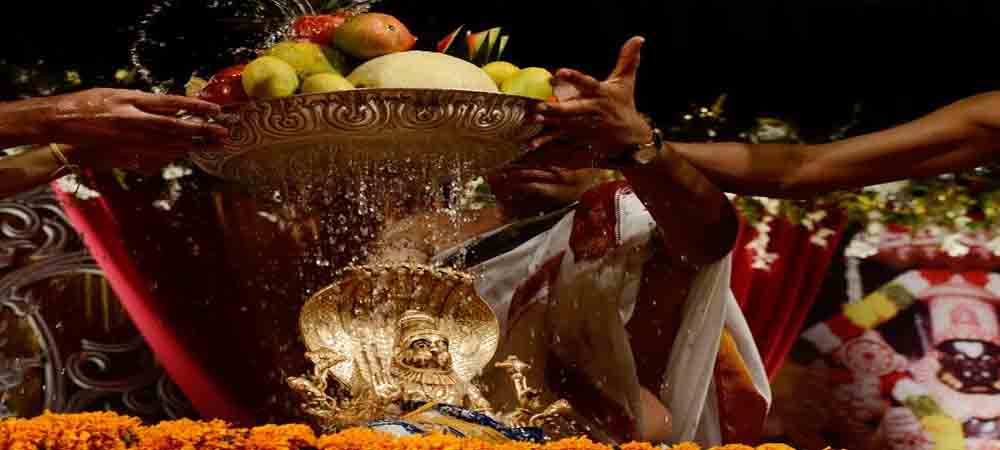
Narasimha Jayanti, the celebration of the birth of Lord Narasimha, is an important festival in Hinduism. Like all Hindu festivals, food plays a significant role in the celebrations of Narasimha Jayanti.
Traditional Food Preparations on Narasimha Jayanti
On Narasimha Jayanti, devotees prepare traditional vegetarian dishes as offerings to Lord Narasimha. Some of the popular dishes include chana dal vada, kesari bath, puliyogare, and obbattu. Many devotees also fast on Narasimha Jayanti and break their fast with these traditional dishes.
Special Offerings Made to Lord Narasimha
In addition to the traditional food preparations, devotees also offer special sweets and fruits to Lord Narasimha. Some of the popular offerings include jaggery, coconut, bananas, and milk sweets. Many devotees also offer neem leaves to Lord Narasimha, as neem is believed to have medicinal properties and is considered auspicious.
Importance of Food in Hindu Culture
Food has always held great importance in Hindu culture and is seen as a way to connect with the divine. Many Hindu rituals and ceremonies involve the preparation and offering of food to the deities. Food is also seen as a way to promote health and well-being, and many traditional Indian dishes use ingredients that are believed to have medicinal properties.
Narasimha Jayanti in Literature and Art
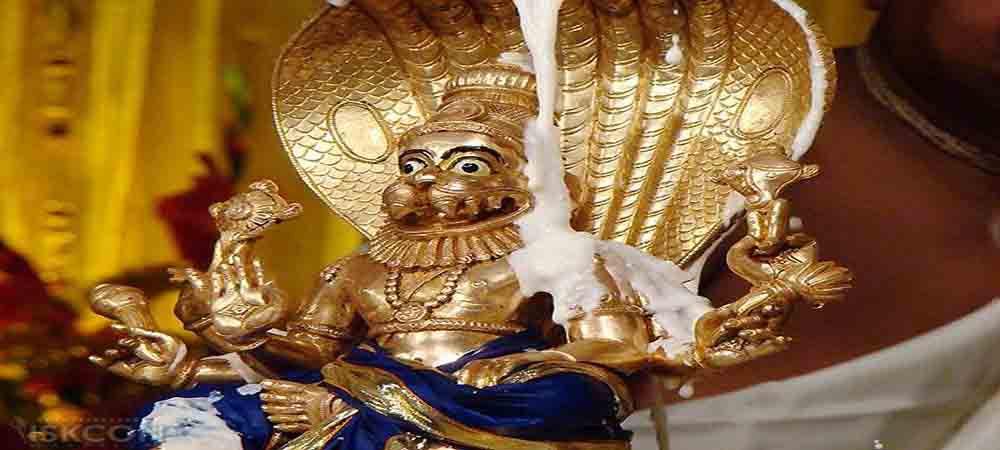
Narasimha Jayanti, the festival celebrating the birth of Lord Narasimha, is a significant event in Hindu mythology, literature, and art. Here are some interesting facts about the Narasimha Avatar’s depiction in literature and art.
Narasimha Jayanti in Hindu Epics
The story of Narasimha Avatar is recounted in several Hindu epics, including the Ramayana and Mahabharata. In the Ramayana, Narasimha Avatar is invoked by Lord Rama to seek protection from the demon king Ravana. In the Mahabharata, the story of Narasimha Avatar is narrated to King Yudhishthira by the sage Markandeya.
Depictions of Narasimha in Classical Indian Art Forms:
The Narasimha Avatar has been depicted in various classical Indian art forms, including painting, sculpture, and dance. The most famous depiction of Narasimha is found in the caves of Ellora in Maharashtra, where a 6.7-meter-tall statue of Narasimha is carved out of a single rock. Narasimha is also a popular subject in classical dance forms like Bharatanatyam and Kuchipudi.
Influence of Narasimha on Indian Literature and Culture
The story of Narasimha Avatar has had a profound impact on Indian literature and culture. The character of Narasimha represents the triumph of good over evil and is seen as a symbol of strength and courage. The story of Narasimha Avatar is also seen as a metaphor for the destruction of the ego, which is necessary for spiritual growth.
Narasimha Jayanti and its Significance in Modern Times
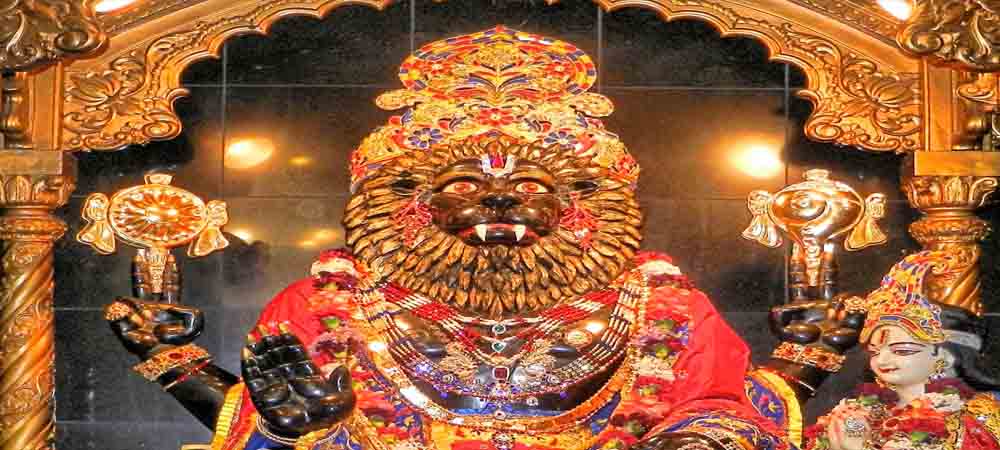
Narasimha Jayanti, which celebrates the birth anniversary of Lord Narasimha, has continued to hold immense significance in contemporary India. Although religious practices and traditions have evolved with time, the essence of the festival remains unchanged. In modern times, Narasimha Jayanti is celebrated with great enthusiasm by devotees across the country.
People celebrate Narasimha Jayanti by visiting temples, offering prayers and performing rituals. Special puja is conducted on this day, and devotees fast and offer flowers, fruits, and other offerings to Lord Narasimha. Devotees also recite Narasimha stotras and mantras to seek blessings from the Lord.
Apart from religious practices, Narasimha Jayanti also has cultural significance. People decorate their houses and streets with lights and flowers, and the atmosphere is filled with joy and festivity. In many parts of the country, processions are carried out, with devotees singing bhajans and hymns in praise of Lord Narasimha.
The celebration of Narasimha Jayanti in modern times highlights the importance of preserving cultural heritage and traditions. The festival serves as a reminder of the rich cultural and spiritual heritage of India and the need to preserve and promote it for future generations.
The Universal Message of Narasimha Jayanti

The festival of Narasimha Jayanti carries a profound spiritual significance that transcends religion and speaks to the hearts of people of all faiths and backgrounds. Here are some of the universal messages that this festival conveys:
Understanding the Deeper Spiritual Significance of Narasimha Jayanti
The story of Narasimha Avatar reminds us that God takes different forms to protect his devotees and restore the balance of the universe. It also teaches us the importance of devotion, faith, and surrender to God’s will. In this avatar, Lord Vishnu showed his fierce side, which was necessary to destroy the evil king Hiranyakashipu, who had become a threat to the world.
Lessons from Narasimha Jayanti for People of All Faiths and Backgrounds
The story of Narasimha Avatar teaches us that the ultimate purpose of life is not to accumulate wealth, power, or fame but to cultivate virtues like love, compassion, and righteousness. It also reminds us that true happiness comes from within, and external circumstances can only provide temporary pleasure.
The festival of Narasimha Jayanti promotes the idea of unity in diversity and encourages people to celebrate the richness of their cultural heritage. It also promotes the message of peace, love, and harmony, which is essential for the progress and prosperity of any society.
How the Festival Promotes Peace, Love, and Harmony
The festival of Narasimha Jayanti brings people from different backgrounds together to celebrate a common cultural heritage. It provides an opportunity for people to learn about the story and significance of Narasimha Avatar and reflect on its universal messages. The festival also promotes the values of respect, tolerance, and inclusiveness, which are essential for building a peaceful and harmonious society.
Frequently Asked Questions
Why is Narasimha Jayanti celebrated?
Narasimha Jayanti is celebrated to commemorate the birth anniversary of Lord Narasimha, an incarnation of Lord Vishnu. It is believed that Lord Narasimha appeared on earth to protect his devotee Prahlada and to destroy the demon king Hiranyakashipu.
Which day is special for Lord Narasimha?
The day of Narasimha Jayanti, which falls on the 14th day of the Hindu month of Vaishakha (usually in April or May), is considered to be special for Lord Narasimha.
How is Narasimha Jayanti celebrated?
Narasimha Jayanti is celebrated by performing special puja and offering prayers to Lord Narasimha in temples and homes. Devotees also observe fasts and recite mantras and hymns dedicated to Lord Narasimha. In some regions, cultural programs and processions are also organized to celebrate the occasion.
When did Narasimha born?
As per Hindu mythology, Lord Narasimha was born on the 14th day of the Hindu month of Vaishakha. This day is celebrated as Narasimha Jayanti.
Why was Narasimha so angry?
Lord Narasimha appeared in his half-lion and half-human form to destroy the demon king Hiranyakashipu, who had become arrogant and started considering himself as God. When Hiranyakashipu’s atrocities crossed all limits, Lord Narasimha appeared to restore balance and protect his devotee Prahlada.
Why did Shiva fight Narasimha?
There is no record of any direct fight between Lord Shiva and Lord Narasimha in Hindu mythology. However, in some versions of the story, it is believed that Lord Shiva appeared in the form of Sharabha (a mythical creature) to pacify Lord Narasimha, who was in his fierce and angry form after killing Hiranyakashipu.

